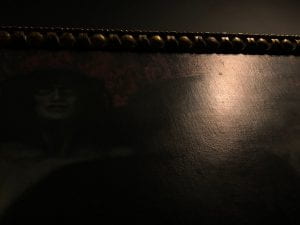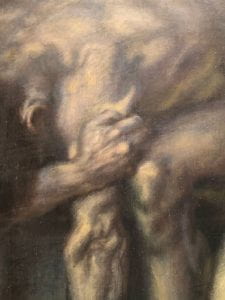After spending a few hours roaming around the Metropolitan Museum of Art, you will see that there is no piece of artwork quite as viciously dark and demonic as Inferno by the German artist Franz von Stuck, an oil painting completed in 1908. Von Stuck was undoubtedly exploring the sinful, evil nature of human beings and the concept of an eternal hell, but I believe that there is a deeper message, a warning of punishment to humanity. The threat of the afterlife is depicted by von Stuck in this painting through his use of layering the subject matter containing traditional motifs and symbols, positioning of figures and facial expressions, and impossibly smooth brush strokes featuring a grim color palette.
The composition of this painting is designed in a way that leaves out a main focal point. It is three distinct layers: the lone, dark figure at the front, the group of contorted figures painted in lighter colors in the center, and the burning fire in the very back. The layer of fire is depicted in a red so radioactive compared to the rest of the painting, which lacks any bright color scheme at all, that it was the first thing I noticed. I felt a clear visual and emotional movement to this work; as my eyes shifted from the fire to the figures and especially the facial expressions, I felt more and more of the painting’s depressing yet frightening energy.
The painting technique and color palette used by von Stuck works effectively with the theme. The delicate, smooth brush strokes portray pale, ghastly figures that seem to be in an alternate state of mind. The use of oil paint made it possible to blend the colors in a feathery yet seamless method, giving little to no physical texture to the painting. The color palette, consisting of an arrangement of cool-tone grays, excluding the fire, is morbid and grim, adding to the gruesome atmosphere.
Figure 1 There is little to no physical texture
Figure 2 The smooth painting technique gives the effect of ghostly, pale skin
We receive one direct facial expression exclusively from the rest of the figures by the upper left corner of the canvas. It is a face with eyes so monstrously wide, blurry yet piercing, with no clear differentiation between the pupil and the sclera. The figure is jolted with shock and horror, suggesting a sense of permanence and being stuck there forever, its head surrounding by a thick, jet black outline that separates the background of fire from the one containing the figures. It is high up within the hierarchy of the subject matter, the expression being so frightful that it took me longer than normal to notice the highly sexualized female body on the right side, being strangled by a snake. The other expressions we see are those of a demon-like figure sticking out from the left, pressing onto a breast, and on the right side, two faces that are only partially visible, drenched in a pain that seems unimaginable to me.
The subject matter itself is quite traditional and literal. The snake, the demon, and the burning fire- it all directly points to the theme of hell and sin; this may be a result of the Symbolism movement and the style of using motifs of mythological and mystical ideas that was prominent in late 19th century France The snake, looking highly satanic, wrapping itself around the female figure may have been a reference to the story of Adam and Eve and the forbidden fruit, which is also the first biblical story of human sin. Every single one of the figures are depicted in a state of pain, shock, or shame- as if they are being tortured or punished. I also want to make a note of the high level of drama happening in this scene, especially with the female figure- who is portrayed powerlessly, resisting the choke of the snake in a state of shock.
At the forefront, the single, dark figure is sitting in a hunched position, face in his hand. This is the figure that holds the most significance, because it is the only one that we as viewers can relate to- the darkness makes it difficult for us to see any details, which automatically makes it the most ordinarily portrayed figure in the painting. He is facing the nightmarish scene before him, witnessing it along with us. The inclusion of this figure has led me to conclude that this artwork is a warning of what is to come after death, after we have finished leading gluttonous lives of sin.
This painting was created right around the inception of the Expressionism movement, and its characteristics can be definitely seen in Inferno– a highly emotional energy is being unleashed onto the canvas through the dramatic facial expressions and positioning of the figures. The painting severs from the concept of modern human life and the metropolis by going back to concepts of myth and religion, yet it is depicted, especially with the figures, in a highly modern style.
Both literally and metaphorically, this painting is a layered one, visually stimulating and interesting yet thought-provoking. The entirety of its physical qualities, being quite literal and traditional, work in the favor of the concept in a way that makes it simple to decipher the ultimate message of the painting, which is undoubtedly a deep and dark one.


